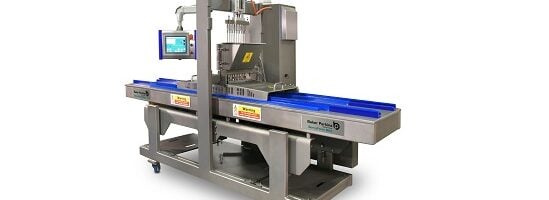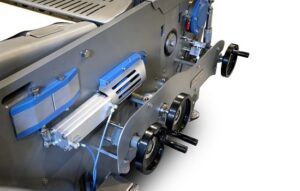
Precision is the foundation of quality and consistency in rotary moulding, the industry-standard method of making soft dough biscuits.
Control of process variables including weight, size and texture is the route to unvarying accuracy – and the key to control is adjustability.
Each adjustment available on a rotary moulder enhances control over the process and reflects directly on the end product. Our TruClean™ Series3 rotary moulder is a high-specification machine capable of high outputs of a full product range – simple or intricate, thick or thin, small or large. The full complement of adjustments incorporated into the Series3, managed individually and independently, combine to ensure production is thoroughly secure.
Independent drives and settings sustain optimum performance by adjusting and maintaining all critical process parameters such as roll and web speeds, forcing roll gap and speed, scraper position and web tension.

The Series3 has three independent drives, to the forcing roll (1), moulding roll (2) and web (3). The speed of all three can be adjusted independently.
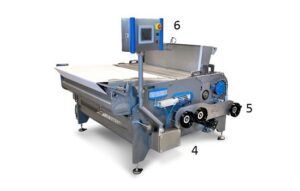
Continuous rotary moulding at peak speeds of 40 metres/minute demands rapid transfer of dough into the cavities of the moulding roll. The relationship between the speed of the forcing and moulding rolls, in conjunction with the ability to adjust the gap between those two rolls (4), provides tight control and protection from issues including under-filled cavities, poor extraction, and variable weight.
The scraper knife (5) is also adjustable and another factor in strict weight control. Regulating the position of the knife to clean the mould surface thoroughly gives smooth dough pieces and allows fine tuning of the piece weight. As the scraper moves around the moulding roll tangentially, the angle of the blade relative to the roll is constant – another contribution to consistency.
The profiled scraper tip reduces product drag after passing the tip, helping to ensure the leading edge of the cavity is filled with dough. More specific profiles can be applied when there are problems with forming and maintaining the forcing roll blanket, although these actions would be considered last resort.
As an aside, it is essential that the scraper is clean, undamaged and changed regularly.
Clean extraction of the dough piece from the mould is essential. Here, the pressure of the rubber roll which pushes the web towards the moulding roll is crucial. Monitoring and adjusting this pressure (6) ensures dough is extracted cleanly onto the web and does not adhere to the moulding roll; and that weight, waste, tailing and cleanliness issues are not created by excessive pressure.
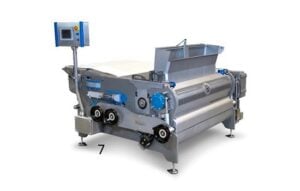
The rubber roll pressure can additionally be adjusted independently from side to side (7) to achieve uniform extraction from the mould. Extraction can be further aided by adjusting the surface finish of the cavity, involving texture, coatings and material.
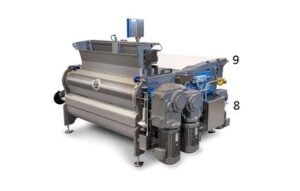
The separate and independent drive to the extraction web (8) allows extraction to take place on the tension side of the web circuit. This is significant – the web must be under tension to ensure clean extraction.
Extracting on the tension side maximises control over extraction, and allows a small speed differential when necessary. This prevents dough breaking and/or being left in the mould cavity, and avoids applying excess tension to the web, which can shorten its life. The speed ratio also allows for minor adjustment of the baked product shape and dimensions, and gives the ability to maintain dimensional stability as dough conditions vary during and between batches.
Insufficient tension and friction drive arrangements common on more basic rotary moulders extract on the slack side of the circuit.
Finally, the height of the nose piece at product discharge (9) is adjustable. It can be set as close as needed to the panner or oven band. Transfer must be accurate and consistent across the full working width of the plant to ensure definition of product shape. This is achieved through geometry and design of the scraper
These features are the result of Baker Perkins’ development of biscuit making technology over decades. Individually and collectively, we fine-tune and regulate the rotary moulder. Every kind of dough and every size of product can be produced at high speed and optimum quality.





